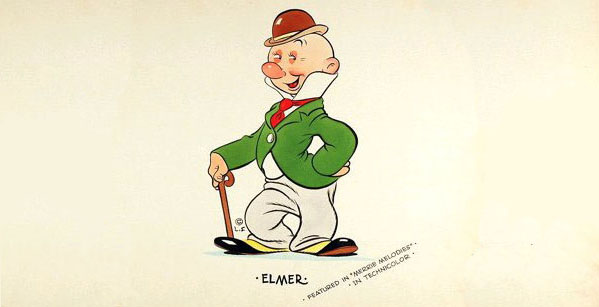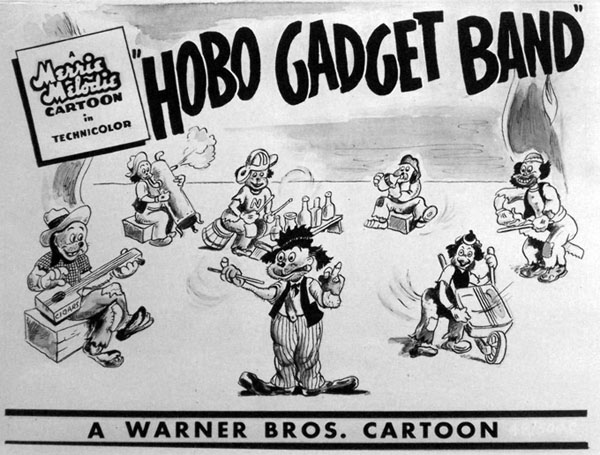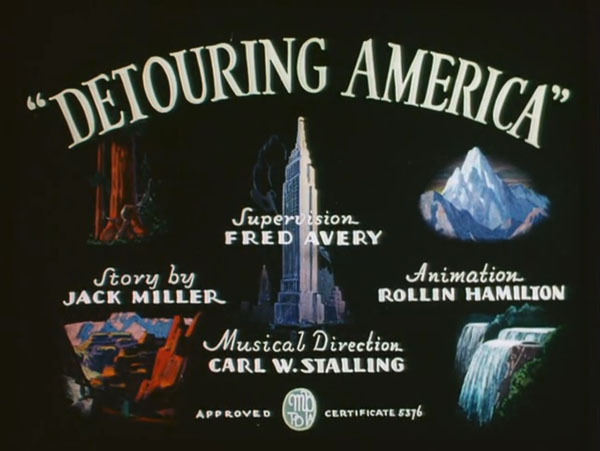We continue with the first of many LONG seasons of Merrie Melodies to come. The Warner animators were not only creative, but prolific in output – a profitable combination of character traits, to say the least.

A Day At the Zoo (3/11/39) – Spot gags at the Kalama-Zoo, including a running gag involving a fella (Egghead) who annoys a lion with his walking stick, and gets it in the end. One of the first cartoons to take off on Lou Costello’s catch phrase, “I’m a bad boy!” (A&C were already known for their appearances on the Kate Smith radio show.) As for songs: listen carefully and you’ll hear bits of “Animal Fair”, “Mess Call”, “California, Here I Come”, “Confidentially”, and “The Girl Friend of the Whirling Dervish”.
Prest-O Change-O (3/25/39) – The two curious puppies find themselves in the home of Sham-pu the Magician, and find themselves as bewildered as in the House of Tomorrow in Dog-Gone Modern. Another early vehicle for Bugs’ Bunny. “The Umbrella Man” is heard on the score, a song not only popular here, but even more so in England. Here, Connee Boswell recorded it for Decca, Kay Kyser for Brunswick (below), and Johnny Messner for Bluebird. In England, versions appeared byFlanagan and Allen on Columbia, Ambrose on Decca, Nat Gonella for Parlopjone, The Organ, the Dance Band and Me (a group directed by Billy Thorburn) also on Parlophone, Billy Cotton on Rex, and the London Piano Accordion Band on Regal-Zonophone.
Bars and Stripes Forever (4/8/39) – Spot gags on prison life, making fun of the tropes of every prison picture Warners ever produced. “Warden Paws” is a reference to Warden Lewis Lawes, the warden of Sing Sing prison in New York, and who wrote the book “20,000 years in Sing Sing”, made into a Warner feature back in 1933. Songs: “Day Dreaming (All Night Long)”, with special lyrics (“I’m Going to Scram From Here”, delivered a la Jerry Colonna), recorded by Glenn Miller on Bluebird, Sammy Kaye on Victor, Bing Crosby on Decca, and Red Norvo on Brunswick (below). Also heard again, “The Umbrella Man”.
 Daffy Duck and the Dinosaur (4/22/39) – In Daffy’s third appearance in Technicolor, Casper Caveman (a parody of Jack Benny), decides to hunt for a duck breakfast, assisted by his trusty dinosaur Fido. Prehistoric times put no damper on Daffy’s usual early nutty antics. A long panning shot of Burma-Shave type signs leads the Caveman to a humongous pneumatic duck (a baloon, with Daffy manning the tire pump). The gag backfires when Casper attacks it with a knife – and the whole cast winds up at the pearly gates, with Daffy acknowledging “Maybe this wasn’t such a hot idea after all.” Songs include “Long, Long Ago”, “Woo Woo” (for lack of a better title, to become Bugs’ Bunny’s early theme), Mendelssohn’s Spring Song”, and a five-note ending coda associated with the musical jingle of Benny’s sponsor, “J-E-L-L-O”.
Daffy Duck and the Dinosaur (4/22/39) – In Daffy’s third appearance in Technicolor, Casper Caveman (a parody of Jack Benny), decides to hunt for a duck breakfast, assisted by his trusty dinosaur Fido. Prehistoric times put no damper on Daffy’s usual early nutty antics. A long panning shot of Burma-Shave type signs leads the Caveman to a humongous pneumatic duck (a baloon, with Daffy manning the tire pump). The gag backfires when Casper attacks it with a knife – and the whole cast winds up at the pearly gates, with Daffy acknowledging “Maybe this wasn’t such a hot idea after all.” Songs include “Long, Long Ago”, “Woo Woo” (for lack of a better title, to become Bugs’ Bunny’s early theme), Mendelssohn’s Spring Song”, and a five-note ending coda associated with the musical jingle of Benny’s sponsor, “J-E-L-L-O”.

Thugs With Dirty Mugs (5/6/39) – A Tex Avery sendup of the cliches of Warners’ gangster picture, starring Ed. G. Robemsome. Not only does the killer do Eddie Robinson well, but does a good Fred Allen impersonation too, until his henchmen tell him to quit showing off. It features another of Avery’s audience silhouette gags, as a patron who’s seen the picture more that once tips off the cops as to the killer’s whereabouts. “Thanks, ya little tatteletale”, replies the officer. Songs: “It Looks Like a Big Night Tonight” (below), and “Jeepers Creepers”, played in a minor key.
Naughty But Mice (5/20/39) – Title is a play on Dick Powell’s “Naughty But Nice” of the same year. Sniffles the Mouse has a cold, and sneaks into a drug store, looking for a remedy. Boy, does he find one – the “XLNT Cold Cure” – only 125% alcohol! One spoonful gets him schnockered – and harmonizing “How Dry I Am”, with a living electric shaver, who not only pucks up his cold, but a dose of the cold remedy too. A cat comes along, interested only in his next meal – a fat, juicy “pickled” mouse. Sniffles winds up trapped among the prizes of a claw digger machine, while the shaver comes to the rescue. Songs: “Deep In a Dream”, “You Go To My Head”, and “The Chase” from the William Tell Overture.

Believe It Or Else (6/3/39) – A spoof of the “Believe It Or Not” shorts, based on Robert Ripley’s comics feature collecting oddities from around the world. Egghead has a running gag as a disbeliever, carrying signs such as “It’s a Fake”. Songs: “The Umbrella Man”, “Over the Waves”, an oldie “I Hear You Calling Me”, a song from John McCormack’s repertoire on Victor, “Visions of Salome” – and another oldie “Sweet Genevieve”, which we all know from The Dover Boys.

The Hobo Gadget Band (6/17/39) – Life in a hobo jungle, among the derlicts who sometimes used to refer to themselves as the “Knights of Rest”, with a dog voiced by Pinto Colvig as their de facto leader. After being shaken off a train by the engineer’s “Hobo Eradicator”, the tramps find there’s a musical audition at “the powerful little 5-watter in Rosedale”, a reference to the “EZRA” radio program of the day. Using instruments constructed from bric-a-brac, the hoboes easily win the prize, and are about to be signed up for fame and fortune – but the whistle of an outbound train raises their love of the open road, and they board for parts unknown – after tearing up the contract. Songs: “Deep In a Dream”, “The Old Apple Tree”, “Carolina In the Morning”, and an original number, “The Junktown Gadget Band”, probably written for the cartoon. One wonders if this film was inspiredby groups such as the Hoosier Hot Shots or the (New) Dixie Demons on Decca.

Old Glory (7/1/39) – Warner had for several years developed a sub-genre of Technicolor historical shorts, even earning an Oscar or two for the series. Somehow, the Schlesinger team was convinced to get into the act by producing the first patriotic animated cartoon, released just in time for the Glorious Fourth. Little boy Porky Pig (in his first appearance in 3-strip Technicolor) wonders why he has to memorize the Pledge of Allegiance (the original version, minus the words “Under God”, which weren’t added until the 1950’s). Porky is confronted by no less a figure than Uncle Sam himself, who lays a little American History on him. Songs: old standard favorites and patriotic numbers, including “Columbia, the Gem of the Ocean”, “The Girl I Left Behind Me”, “Yankee Doodle”, “Assembly”, “Oh Susanna” and concluding with “Battle Hymn of the Republic”.
Dangerous Dan McFoo (7/15/39) – One of Warners’ “Northwesterns”, set in the land of ice and snow and based on the “serviceable” poem of Robert W. Service. Around this time, Warner was doing serveal toons set in the snowy regions, including Porky’s “Polar Pals” previously reviewed, and the next cartoon discussed below. This may mark Arthur Q. Bryan’s first voice work for Warner – predating Elmer Fudd. The battle between McFoo and a burly sourdough features many prize-fighting tropes – including a referee giving them instructions before the bout, and a running gag with a trolley car entering the saloon to start each round with its bell. McFoo is also fond of a primitive pinball game – bagatelle style, without flippers or “Tilt”. Songs: “Der Erlkonig” (The Elf King) from German lieder, a go to number for anything with a certain degree of drama to it, and The Old Gray Mare.
Snowman’s Land (7/29/39) – Another North-Western spoof, taking off on popular images of the Northwest Mounted Police. Pinto Colvig plays the hapless mountie sent out to bring in Dirty Pierre. The mountie and Pierre wind up trapped in a rolling snowball, which rolls straight into Mountie headquarters. But Pierre escapes when he appears covered in snow, looking like a living abominable snowman, scaring the Mounties back into the drifts. The featured song is “Song of The Mounted Police”, a mountie march written for the two reel Technicolor musical short, Romance Road (1938). It would receive later use, including for Bugs and Elmer.

Hare-Um Scare-Um (8/12/39) – Another Technicolor vehicle for Bugs’ Bunny – somewhat of a reimagining of “Porky’s Hare Hunt”, with a more distateful protagonist – John Sourpuss, who decides to go rabbit hunting when meat prices go through the roof. (A newspaper headline reads “Meat Prices Soar. Consumers Also Sore.”) Bugs’ Bunny is at his looniest, due to the admitted influence of Looney Tunes cartoons (plugged with Porky Pig billboard). Most prints end abruptly with an edited ending (“I can whip you and your whole family” – responded to by an endless supply of rabbits). However, the uncut version was recently discovered and released – ending a bit similarly to “Daffy Duck and Egghead” with John Sourpuss going crazy. Songs: “Corn Pickin’”, a Johnny Mercer/Harry Warren number from Dick Powell’s Naughty But Nice, recorded on Victor by Maxine Sullivan and on transcription by Jimmy Walsh and his orchestra and by Dolly Dawn and her Dawn Patrol on Vocalion; “A Hunting We Will Go”; and “Woo Woo” with a specialty lyric as Bugs’ unofficial theme song. (He would later revisit the same tune with new specialty lyrics in Easter Yeggs in the 1940’s.)
Detouring America (8/26/39) – Warners would make a regular thing from here on of spoofing travelogues. A running gag about a human fly climbing the empire State Building frameworks this spot-gag reel, including the almost inevitable dogs and trees gag – this time performed by prairie dogs. Nominated for an Academy Award. Songs: “California, Here I Come”, “Yankee Doodle”, “Carry Me Back To Old Virginny”, “Dixie”, “America (My Country Tis Of Thee)” “The Umbrella Man”, “Where Oh Where Has My Little Dog Gone”, “Oh Susanna, and “Brahms’ Lullaby”.

Next Time: Back to Looney Tunes.



 James Parten has overcome a congenital visual disability to be acknowledged as an expert on the early history of recorded sound. He has a Broadcasting Certificate (Radio Option) from Los Angeles Valley College, class of 1999. He has also been a fan of animated cartoons since childhood.
James Parten has overcome a congenital visual disability to be acknowledged as an expert on the early history of recorded sound. He has a Broadcasting Certificate (Radio Option) from Los Angeles Valley College, class of 1999. He has also been a fan of animated cartoons since childhood.












































Bars and Stripes Forever also contains “Monday Morning” and “St. James Infirmary Blues”.
“Der Erlkoenig” (The Elf King), that “go-to number for anything with a certain degree of drama to it,” is one of the most famous songs by Franz Schubert, who composed it at the age of eighteen. It can be found in a great many cartoons of this period, for example at the beginning of Ted Eshbaugh’s “The Snow Man” (1933). The text, an equally famous poem by Goethe, tells of a father riding home with his sick child, who in his fever delirium sees visions of the Elf King. According to legend, seeing the Elf King means that one is about to die, and this indeed is what happens to the poor child.
Although undeniably a masterpiece, the song is very difficult to pull off in concert. The singer has to play three different roles (father, son, and Elf King) as well as the narrator, and the piano part is so difficult that I’ve been told it’s actually somewhat distracting. I know it from recordings and have played instrumental arrangements of the music, but I have never heard the original version of the song performed live.
One of my music history professors told me about hearing “Der Erlkoenig” at a concert back in 1932. At the time the big story in the news was the Lindbergh kidnapping, and the concert took place shortly after the baby’s remains had been discovered. By the time the singer reached the final line (“In his arms the child was dead”), she and everyone in the audience were in tears and sobbing. It was a heart-wrenching performance that still affected my professor deeply when he talked about it fifty years later. I wondered whether the song might have been associated with the Lindbergh tragedy, and become familiar to the general public through radio play, accounting for its frequent use in cartoons of the thirties. But as it happens, Erno Rapee’s compendium of musical cues “Motion Picture Moods for Pianists and Organists” contained excerpts from “Der Erlkoenig”, and Stalling would therefore have made use of the song in his days as a silent film accompanist.
1939 was really a year for clunkers for Chuck Jones.
I know I’m in the minority here but to me most of his cartoons are truly unfunny.
Humor seem to come naturally for Avery and Clampett.
Don’t be too rough on me for expressing my honest opinion.
Chuck himself felt the same way about his early cartoons. Personally, I think Daffy Duck and the Dinosaur holds up the best; it was his first stab at Daffy, and having to deal with that kind of wacky humor got him out of his comfort zone a little bit. He wouldn’t get the hang of just being funny until the early forties.
When i was going through the Looney Tunes shorts chronologically last year, i felt like the year 1940 overall was a year of clunkers for WB in general. Apart from “Elmer’s, Candid Camera”, ‘A Wild Hare’, and “You Ought To Be In Pictures”, there really aren’t any noteworthy shorts during this period, with only two Daffy Duck shorts, and Tex Avery seeming like he was just going through the motions.
I disagree to an extent- 1940 won’t go down as one of the all-time great WB years but I thought it was an improvement over 1939’s cartoons (ironic, because 1939 is often heralded as the greatest year in cinema history by many film scholars). Friz had returned to the studio and hit a few home runs right out of the gate, Porky’s cartoons were still entertaining, and while Tex’s spot gag cartoons weren’t anything special or inspired, they still had some funny gags. Really, the only weak link was Chuck Jones, but thankfully his cartoons would improve substantially starting in 1942.
The latter part of the 1938-39 season is really when Warners’ got out of overtly plugging their songs in the Merrie Melodies by having the cartoon (in Friz Freleng’s words) stop dead for a musical number, and started using the studio’s song library either as supporting background music or better integrating the songs that were used into the storyline of the cartoon. It was another step towards the finished product the Schlesinger studio would have by the end of the 1941-42 release season.
And thus we say goodbye to the enigmatic Egghead, and welcome the official Elmer Fudd next year.
Always enjoy this series, James. Pinto Colvig, who did the lead hobo character in Gadget Band, was briefly on staff as a gagman and writer before he left for Florida (principally to do Bluto). He mentioned writing both the hobo song and the happy little baker-men number for the next season’s BUSY BAKERS. I believe a PR shot of him in hobo garb and with his trademark clarinet was printed in an old Funnyworld issue, quite likely to publicize the Hobo Gadget Band cartoon. It was sung by him most engagingly, and supported by the Paul Taylor quartet who were also known as The Sportsmen and who were heard in many Schlesinger cartoons between 1937-43.
I have to always echo Keith Scott’s enthusiastic response to this series of posts, but while I should double check myself from my own collection, doesn’t “DANGEROUS DAN MCFOO” contain a bit of “The Poet and the Peasant”? I won’t go into how many times that piece was used in cartoons, no matter what the studio. So Pinto Culvig actually wrote tunes for the Warner Brothers cartoons; and I like the two songs you mentioned.
“Woo Woo” was also used in “Daffy Duck and the Dinosaur” that you noted, James; and in Hop, Look, and Listen, which gave us Hippety Hopper.